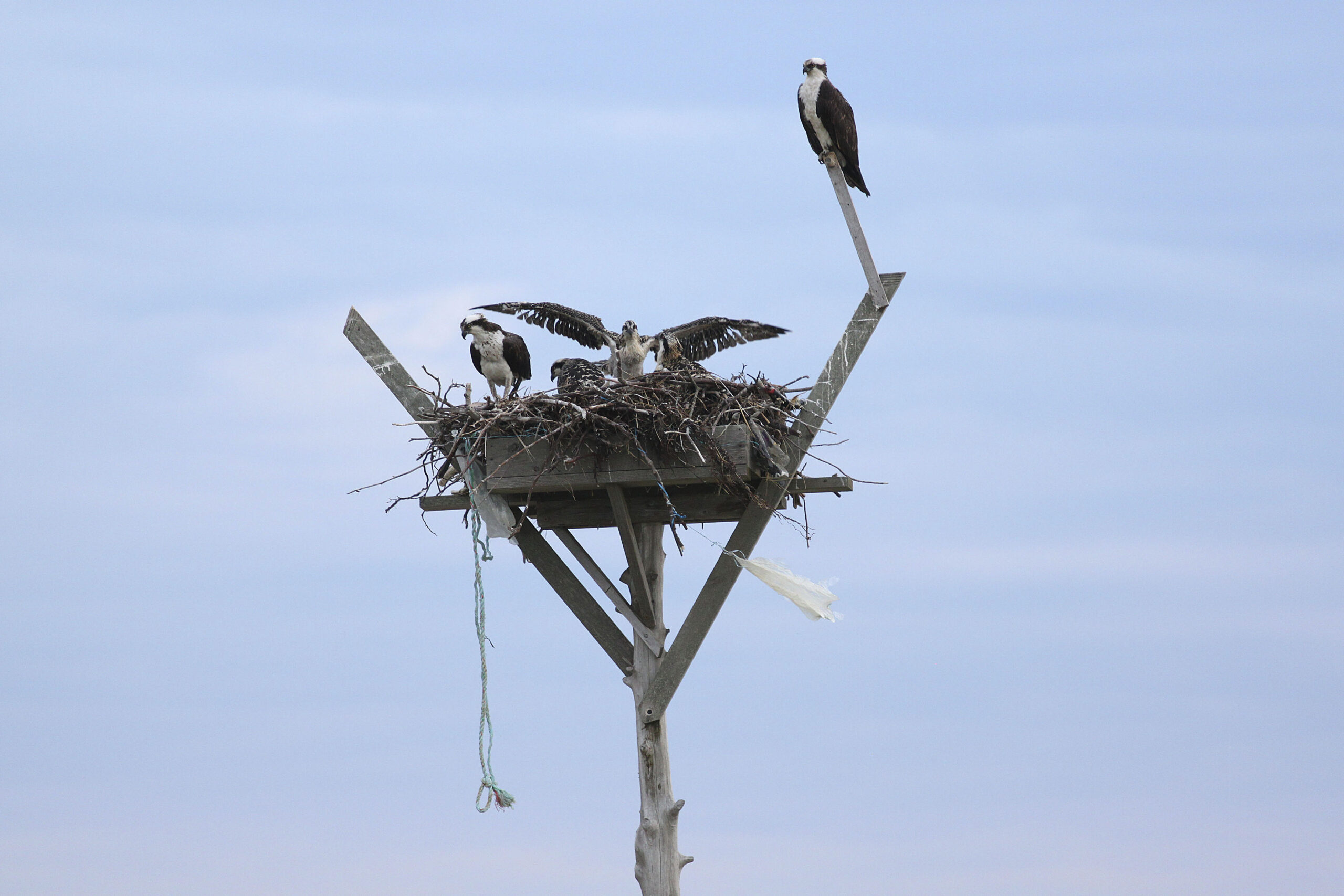
One of first jobs that Bob DeLuca had on the East End was erecting an osprey tower at the Elizabeth A. Morton National Wildlife Refuge in Noyac, part of a mounting effort at the time to revive the endangered, locally iconic raptors. At the time, the mid-1980s, there were maybe 100 ospreys in the region, he reported.
And in the nearly four decades since, he has watched their population soar.
Last summer, the Group for the East End, where DeLuca serves as president, monitored 477 nesting sites in the five East End towns and documented 353 active nesting pairs, which produced 505 fledglings.
Just eight years prior, in 2014, the number of active nests was just 199.
“I think it’s very safe to say that there is a strong upward trend in the East End osprey population that’s documented every year that we go out there,” DeLuca said. “We’re looking at over 500 fledglings every year now, coming off about 350 active nest sites.”
That wasn’t always the case. The osprey decline began in the 1950s and accelerated through the 1970s with the increased use of DDT, an insecticide that resulted in eggshell thinning, causing them to be more easily crushed during incubation. In 1976, the apex predators were listed as endangered in New York State, only rebounding in the early 1980s with the ban of DDT.
In 1983, the level of concern for ospreys was downgraded to “threatened,” and by 1995, there were 230 breeding pairs on Long Island. Four years later, the white-bellied birds were downgraded once more, this time to “species of special concern,” which is its current status.
“Seeing them come back and seeing apex predators come back — it’s like wolves or polar bears or anything else, those species that are at the top of the pile — they are quite sensitive to things that go on below,” DeLuca said. “When those species start to do better, it’s a broad indicator that the ecosystem itself is a healthier, more functional system that needs less help from us.”
Southampton Town was among the most active locations on the East End, with 112 of the 154 monitored nesting sites showing activity, and 139 fledglings counted. In East Hampton Town, staff and volunteers monitored 63 sites, 49 of which were active, producing 84 fledglings, not including Gardiners Island.
On Shelter Island, 37 of its 52 sites showed activity, resulting in 60 fledglings, not including Mashomack Preserve.
In Riverhead, 25 potential nesting sites were monitored and 19 showed activity, producing 29 fledglings. The highest number of fledglings, 193, was found in Southold, where 136 of its 183 sites were active, even without including Robins Island, Plum Island or Fishers Island.
“The osprey is an iconic emblem of the region, and I think when people see them, it’s one of the ways that people are drawn to nature,” DeLuca said. “You can’t watch an osprey dive in and catch a fish without feeling some sense of humility about the amazing aspects of nature that we live with — and it makes people care a little bit more.”
In addition to the threat of pesticides, wetlands destruction also carved away the osprey’s nesting habitat at an accelerating pace. As the osprey population increases, many birds have begun to nest naturally in trees, while others find themselves on docks, chimneys, light posts and utility poles — places that can lead to conflicts with humans or injuries to the birds.
Over the past three decades, the Group for the East End has installed and maintained more than 250 osprey nesting platforms — much like the one DeLuca put up in Noyac — and, in 2021, the organization partnered with PSEG Long Island to survey approximately 600 utility poles that would be of the highest risk to nesting ospreys and relocate existing nests.
Of the 200 poles identified as problematic, all high-risk and some medium-risk poles have received V-guard installations — a physical deterrent covering electrical infrastructure to discourage new nests — and as that work continues this year, the Group will also host a training for PSEG staff to discuss the history of the osprey and how to identify hazards, as well as address potential conflicts.
“A lot of times, these birds have found their way to the top of telephone poles, which are electrified, and they can end up in harm’s way and literally burst into flames or electrocute themselves,” DeLuca said. “They may be able to have a nest there for a year or so, and maybe nothing will happen, but I’ve now picked up two birds that have essentially gotten electrocuted out east, and it happens. So nobody likes to have that be the outcome.”
Ultimately, the goal is help reestablish the osprey in its traditional nesting areas, such as snags, treetops, or crotches between large branches and trunks, while leaving the erected nesting poles intact to provide more homes for a growing population — so that they don’t end up on chimneys, DeLuca said.
“We obviously have gotten a number of things to work on — water quality problems, overdevelopment, things like this — but the bottom line is that bird has gone from virtually extinct on Long Island to back in numbers that probably are pretty close to what it was prior to its decline,” he said. “It’s come full circle, and it’s also a nice metaphor for what we hope can happen in a lot of environmental fronts.”